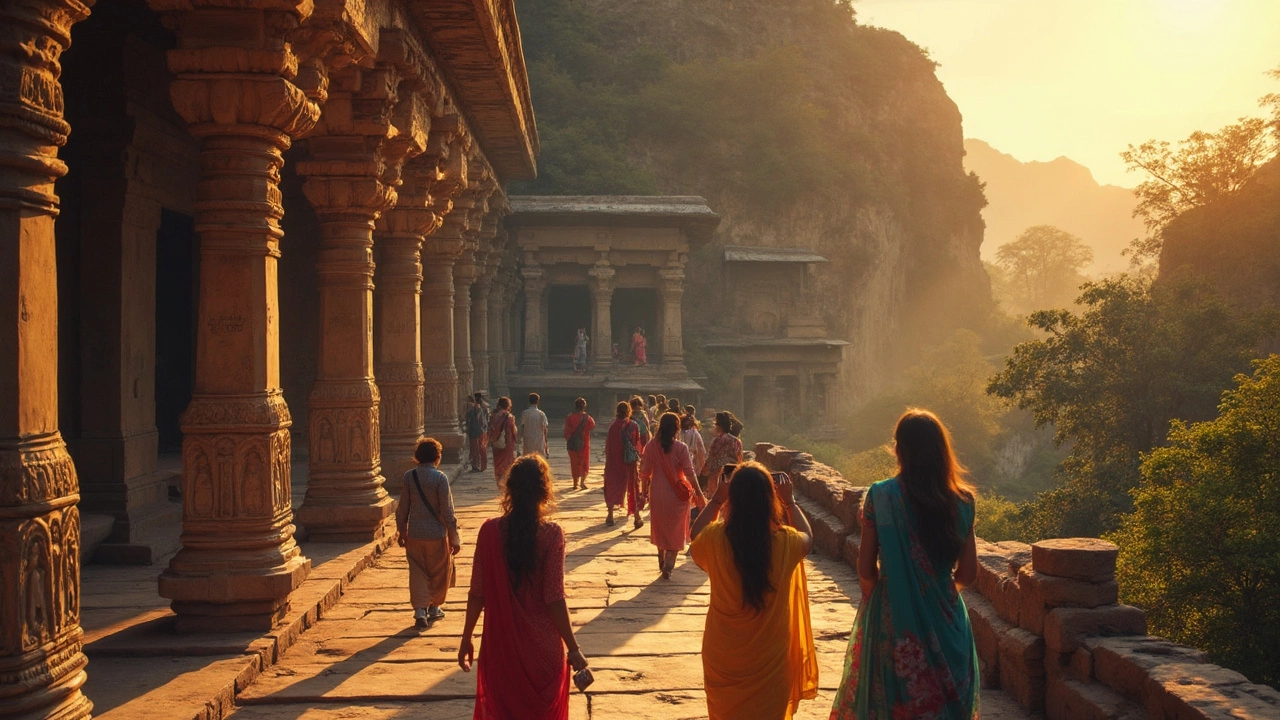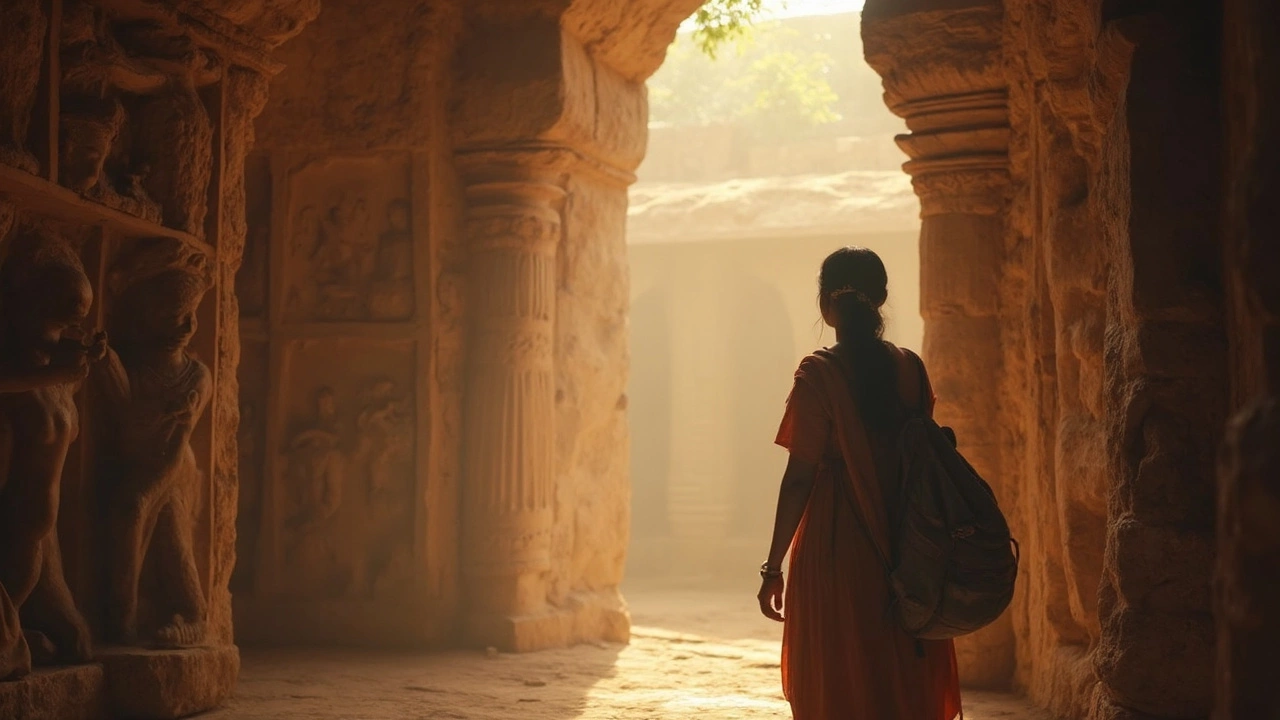UNESCO Heritage Sites in India: The Newest Addition Explained
 May, 21 2025
May, 21 2025
Think you've seen everything India has to offer? There's a fresh name on the UNESCO heritage list that might just surprise you. Every year, getting that UNESCO tag isn't easy. It means a place has something so unique or important that the world agrees it should be protected forever.
India's latest spot to snag this honor happens to be the Sacred Ensembles of Hoysala — yes, those jaw-dropping temple complexes in Karnataka. Officially, UNESCO added the Sacred Ensembles of the Hoysalas (which covers Belur, Halebidu, and Somnathapura) to its World Heritage list in 2023, but most folks only started talking about it when travel picked up again last year. These temples date back to the 12th and 13th centuries, and their carvings kind of look like every stone was sculpted by someone with superhuman patience—and probably really good eyesight.
If you’re into architecture, mythology, or just want a selfie in front of something genuinely rare, you’ll want to know why this new entry matters, what you can actually see there, and how to visit without feeling lost in the crowd. Tons of local guides have cool stories you won’t find in any history textbook, so don’t skip out on the human angle when you go.
- India's UNESCO Journey So Far
- Meet the Latest Heritage Site
- Why the Site Matters
- Visitor Tips: Getting the Most Out of Your Trip
- Hidden Stories and Quick Facts
India's UNESCO Journey So Far
India’s been part of the UNESCO World Heritage party for a while. It all started in 1983 when Agra Fort, Ajanta Caves, Ellora Caves, and the Taj Mahal landed spots on the list. Fast forward to 2025, and the count stands at 41 World Heritage Sites—one of the highest numbers across the globe.
There’s a good mix: ancient temples, wild forests, massive forts, and even modern stuff like Mumbai’s Victorian & Art Deco buildings. The idea behind a UNESCO site? To save really important places—natural, cultural, or both—so future generations can actually see them in real life and not just in grainy textbooks.
Here’s a quick peek at how the list has grown:
| Year | UNESCO Sites in India |
|---|---|
| 1983 | 4 |
| 1990 | 11 |
| 2000 | 23 |
| 2010 | 28 |
| 2020 | 38 |
| 2025 | 41 |
Some quick facts: Three of these sites are natural wonders, like the Western Ghats and Kaziranga National Park. The rest are cultural spots—think temples, forts, and cities that go way back. India also has one mixed heritage site, Khangchendzonga National Park, which is both wild and full of old stories.
Getting a place on the UNESCO list is a badge of honor, but it comes with serious responsibility. India has to keep these sites in top shape, which means repairs, responsible tourism, and making sure traditions don’t disappear. The sites pull in millions of travelers and that helps local businesses big time.
Basically, if you’re planning a trip, building an India bucket list based on World Heritage Sites is a solid place to start. You’ll cover history, nature, and some pretty rad stories in one go.
Meet the Latest Heritage Site
The Sacred Ensembles of the Hoysalas, now recognized as a UNESCO World Heritage site, are actually three temple sites: Belur, Halebidu, and Somnathapura, all located in Karnataka, South India. These aren’t your typical temples—they’re famous for super detailed stone carvings, unique star-shaped platforms, and quirky little surprises like secret corridors and sculpted walls covered in thousands of tiny figurines. Basically, every time you look closer, you notice something you missed before.
The Chennakesava Temple at Belur took more than a hundred years to finish. It was started in 1117 AD. If you walk through the front, you’ll see scenes from Hindu epics like the Mahabharata and Ramayana, all carved in stone. Halebidu’s Hoysaleswara Temple, built in the 12th century, is covered in more than 240 wall panels—think of it as the world’s oldest graphic novel, with gods, animals, and daily life all mixed together in the art. Somnathapura’s Keshava Temple, meanwhile, is loaded with intricate ceilings fans out in beautiful patterns. The size isn’t as massive as the others, but the craftsmanship is next level.
Unlike the more crowded monuments around India, these temples are tucked away from usual tourist routes. That means you’ll get real elbow room to soak up the sights and click those photos without heads photobombing your frame. Each spot has its own vibe—Belur has big festivals, Halebidu’s atmosphere feels quieter, almost like stepping back in time, and Somnathapura invites you to just wander and stare at the carvings for hours.
All three sites were added as a joint nomination because they show off the original ‘Hoysala style’—a look you won’t find anywhere else in the country. Nobody’s entirely sure how the old builders pulled off some of these designs using only simple tools. Today, experts still scratch their heads at the sheer detail packed into every block. So, if unique art and history interest you, this site isn’t just another temple stop—it’s a masterclass in ancient engineering and storytelling.

Why the Site Matters
The Sacred Ensembles of the Hoysalas aren’t just another group of old temples. They stand out for their insane level of detail—you'll literally find stories from Hindu mythology carved onto every column and wall like a 900-year-old comic book. UNESCO picked these sites because they show off the unique Hoysala style: star-shaped platforms, super-dense sculptures, and a structure that’s different from anything found in North or even South India.
Here’s what makes the site such a big deal:
- UNESCO recognition: Not every pretty building gets on the list. UNESCO checks if a site has things you won’t find anywhere else and if it’s really changed history in some way.
- Hoysala architecture: It mixes styles from Chola, Chalukya, and Northern Indian temples but takes things way further. Think thousands of small carvings—animals, gods, even dancers—packed so tight you’ll spot something new every time you visit.
- Cultural mashup: You’ll see a blend of Shaiva, Vaishnava, and Jain traditions, all coming together under the Hoysalas. This mix isn’t common in temple complexes, especially with so many artistic details.
Want some stats? Check out this quick table for bragging rights at your next road trip:
| Fact | Detail |
|---|---|
| Main Temples | Belur (Chennakeshava), Halebidu (Hoysaleswara), Somnathpura (Kesava) |
| Year Built | Between 1100 and 1300 AD |
| Carvings Per Temple | Over 20,000 individual sculptures (across complexes) |
| Main Materials Used | Soapstone, easy to carve yet super durable |
| Visitors Per Year (2024) | Roughly 350,000 across all three sites |
Local artists say even after years of study, they still spot fresh details every time. If you care about Indian history, architecture, or just want to stand somewhere that actually changed the story of temple designs across the country, this is the place.
Visitor Tips: Getting the Most Out of Your Trip
If you’re planning to check out India’s latest UNESCO heritage site, the Sacred Ensembles of Hoysala, you’ll want to get the details right to really enjoy your visit. First off, these sites are spread out across Belur, Halebidu, and Somnathapura in Karnataka, so make sure you plan for some road time. The distance between Belur and Halebidu is only about 16 km, but Somnathapura is a solid five-hour drive south (roughly 230 km), so don’t try to squeeze them all in a single day unless you’re really into car rides.
The best time to visit is between November and February—Karnataka gets hot and a bit muggy, and trust me, you’ll appreciate cooler weather when exploring these open temple complexes. Mornings between 8 AM and 10 AM are great: you beat the crowds, and the lighting makes the carvings pop for your photos.
- Always take off your shoes before entering the temples. There’s a shoe rack at the entrances, and if you miss it, the guards will let you know.
- Local guides usually hang around the gates—hire one for about ₹200-₹500 per temple. It’s worth every rupee for the stories alone.
- Water bottles are a must. Vendors sell them outside, but not inside the complexes.
- Photography is allowed, but drones are a strict no-go.
- Restrooms can be a bit basic at Belur and Halebidu; Somnathapura’s are newer but still simple, so come prepared.
Getting here is easy if you use Mysuru, Hassan, or Bengaluru as your base. Tons of buses connect the towns, and rental cars are popular if you want to move at your own pace.
| Temple Complex | Nearest City | Approx. Distance (from Bengaluru) | Entry Fee |
|---|---|---|---|
| Belur | Hassan | 220 km | ₹30 (Indian), ₹500 (Foreigner) |
| Halebidu | Hassan | 210 km | ₹25 (Indian), ₹300 (Foreigner) |
| Somnathapura | Mysuru | 140 km | ₹25 (Indian), ₹300 (Foreigner) |
Dress is casual, but shoulders and knees covered—respect goes a long way. Weekends and school holidays see bigger crowds, especially in December and January. If you’re into festivals, the Mahashivaratri celebrations at Halebidu can be a wild, super local experience, but be ready for serious crowds.
One more thing—cell signal is fine in Belur and Halebidu, but can be spotty in Somnathapura. Grab offline maps if you’re the anxious type. Enjoy the details, snap those carvings, and soak in the history. You’re literally walking through a living legend.

Hidden Stories and Quick Facts
Here’s the cool stuff most people miss about the Sacred Ensembles of Hoysala. For starters, those temples aren’t just old—they’re a masterclass in detail. Each panel lines up thousands of carved figures, and if you count just the unique sculptures around the main sanctum of Halebidu’s temple, you'll hit over 240 different madanikas (celestial maidens). Not one face is the same. The builders used a type of soapstone that’s surprisingly easy to carve but hardens over time, which is why the details still look crisp after 800 years.
If you spot what looks like a Greek column or a bit of Roman influence, you’re not imagining things. Hoysala artists picked design ideas from as far as Persia and Greece—probably thanks to the steady stream of traders that came through South India back in the day. Check out the horizontal friezes; they tell stories from the Mahabharata and Ramayana, plus a weirdly high number of dancing elephants (no idea why they loved those so much).
- There’s a legend that the main temple at Belur was built as the result of a king’s promise to his beloved queen, and that’s why it took more than a hundred years to finish.
- Halebidu literally means "old city" because it was sacked twice—the invaders couldn’t resist the wealth inside.
- Somnathapura is famous for its star-shaped layout, which is crazy rare even for Indian temples. It’s basically an Instagrammer’s dream.
- Most of the original temple doors were studded with precious gems and gold plating—today, you’ll only spot some of the inlay work that survived.
- Want to sound like you know your stuff? Mention the “soapstone” construction—locals call it ‘chloritic schist’, and it’s why artisans could achieve such lifelike figures.
If you’re into numbers, here’s a quick data set that sums up what makes these spots special:
| Temple | Year Built | Main Attraction | Number of Unique Sculptures |
|---|---|---|---|
| Belur | 1117 CE | Chennakeshava Temple & Madanikas | 1,000+ |
| Halebidu | 1121 CE | Hoysaleswara Temple Carvings | 2,000+ |
| Somnathapura | 1268 CE | Star-shaped Keshava Temple | More than 600 |
These UNESCO temples are open most days except for some local festival dates, so planning is easy. Entry fees for Indian tourists are about ₹40, while foreigners pay roughly ₹600. You can hire a local guide for around ₹200-₹300—totally worth it for those unheard tales.
Bottom line: no matter how many temples you’ve seen, this place has a vibe of its own and it totally deserves the UNESCO spotlight.